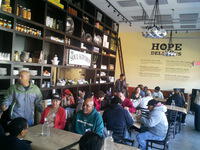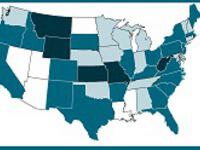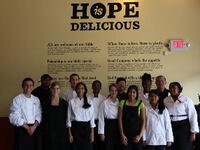Beginning at 9am, people who found themselves in need were invited to the Pilgrim Baptist Church to have access to clothing (adults & children), medical screening, employment services, and access to resource networks. After visiting the church, those participating were welcomed at JBJ Soul Kitchen which is located just around the corner. Soul Kitchen was open from 10am until 2pm, serving hot sandwiches, hot bowls of chili, and beverages to those in need as well as the volunteers.
In Monmouth county, Project Homeless Connect is done on the same day as the nationwide Housing Inventory and Point-In-Time Count of Homeless Persons that identifies unsheltered individuals. “Much advance planning went into this day and now that Soul Kitchen is in this community we felt we needed to be a part of this day’s events”, said Mimi Box, Executive Director of JBJSF.
Serving 126 meals to the community was an important role, but more important was the connection that JBJ Soul Kitchen and staff were able to make with those who came inside to share the warmth of good company and learn about Soul Kitchen. “Many were first time visitors and immediately, upon learning about our model, expressed an interest in providing volunteer services in the community in exchange for the ability to feed their families a healthy, nutritious meal”, said Heather Goldfarb, Marketing & Events Manager at the JBJSF.
Please see the story below from Asbury Park Press for more information on the Project Homeless Count for all of Monmouth County, NJ:
Monmouth homeless survey records greater numbers
Written by: Nina Rizzo | Asbury Park Press Staff Writer
Mild temperatures and the promise of free breakfast, clothing and medical checkups may have helped bump up the numbers for this year’s annual surveys to count the Shore area’s homeless and potentially homeless population.
Jeffrey Schwartz, who oversees Project Homeless Count for the Monmouth County Department of Human Services, said 527 people were counted at four sites, up from 291 last year counted at three snow-covered sites. The numbers include counts taken by volunteers who traveled to potential homeless hangouts throughout the county.
“This is an excellent count,” Schwartz said, adding this was the highest tally in recent years. “We know there are more folks out there, but this represents a very strong acknowledgment that there are people in need.”
The survey results — along with the number of people staying this week at shelters run by emergency and transitional housing agencies — are forwarded to the U.S. Department of Housing and Urban Development to get a snapshot of homelessness in America. Federal funding for housing programs in the county is tied to these survey results.
Monmouth received more than $2.5 million in renewals for supportive housing programs last year, up $400,00 from 2010, the county’s biggest boost of federal funds yet, Schwartz said.
Every dollar is needed. The county starts each day with 500 homeless clients who are staying in shelters, motels, boarding houses and other emergency housing. But this survey is to find the folks who have escaped the social safety net — the ones sleeping on a park bench or in tent cities or at a friend’s house.
Some men who came to New Beginnings Agape Christian Center in Freehold, one of the survey sites, were just looking for the give-aways, but their attendance gave social services providers a chance to talk about their programs.
Felix Aguilar, 20, of Freehold has been living with an uncle since he came from Puebla, Mexico, four years ago. He works as a bus boy at a local restaurant that doesn’t offer health insurance. He came for a flu shot and medical testing, he said through an interpretor.
Silvano Bruno, 38, of Freehold is an out-of-work landscaper who came for a new coat and to learn if he qualifies for emergency shelter. He has been sleeping on a friend’s sofa and won’t be trimming hedges again until spring.
Willie Jamison, a 37-year-old recovering addict living at a local men’s shelter and wants to take advantage of programs that can help him put his life back together.
An Asbury Park native who only reached the 10th grade, he abruptly quit his job at a rehabilitation center in Atlantic County in June 2009 after a dispute with his child’s mother. He has yet to find employment closer to home and has lived most of that time in a relative’s garage without her knowledge.
“This is beautiful,” he said, sitting with a garbage bag full of winter clothes between his legs. “I didn’t know there was that much help out there.”
Jamison’s goal is to get a G.E.D. and become a long-distance truck driver.
Monmouth County worked with at least 70 nonprofit groups, government agencies and private companies to offer social services, medical screenings, legal advice, used clothing, blankets, tioletries and food.
Charles D. Brown III, director of the county’s Department of Human Services, said many homeless people prefer to remain reclusive but he hoped the free items and special services would entice them to come in and be counted.
John Kirch, 62, has been homeless for more than a year. He participated in the survey at St. Mark’s Soup Kitchen in Keansburg, where he is a regular.
“I think (the county) is trying to get as much information as they can to help as many people as they can with the little money that they have,” Kirch said.
Monmouth County Freeholder John Curley, human services liaison, said he came to New Beginnings to talk to the residents about their situations.
He said he was pleased so many nonprofit groups and private companies sent volunteers to help administer the count.
“So many people are falling through the cracks. Our responsibility is that we lift them,” Curley said.
Curley said the county just hired 21 new intake workers to assist residents who apply for welfare, food stamps and other social services.
The food stamp office alone has a three-month backlog, and many of those new hires will be sent to that office when they complete training in April, he said.
Owen Redmond, program director of community development for Monmouth County, said Wednesday marked the first time the annual survey was conducted in Keansburg.
The site was added because of the large number of local nonprofits that work with the homeless there, Redmond said.
Swartz said of the 527 people who filled out the Point In Time survey, 25 went to the Keansburg site.
Some 165 were counted in Red Bank, 149 in Asbury Park, 145 in Freehold and 43 by the mobile volunteers.











